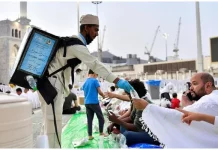The capital of Germany, Berlin is a hub of touristic activities. It offers something for everyone, whether you are looking for history and culture or you want to experience the exciting art, music, and nightlife. Berlin is a mixture of beautiful architecture from different eras and the city is buzzing with life.
So if you’ve planned a trip to this amazing destination, we’ve compiled a list of the best things to do in Berlin. Here you will find what places to see in Berlin and the main Berlin points of interest.
Berlin has an amazing history. It is filled with places of significance from its many wars and conflicts. Even though a lot of it was destroyed during the war, the city was rebuilt with the intention to preserve its history. Because of this, the list of the things to see in Berlin could be endless. However, we’ve compiled the top 15 main Berlin tourist attractions.
1. The Brandenburg Gate
 The Brandenburg Gate is Germany’s and Europe’s symbol of unity and peace. It was built in 1791 based on Athens’ Acropolis and is 26 meters tall with 6 columns and 5 walkways. It is one of the most famous monuments in Berlin as it used to be a dividing point between the West and the East.
The Brandenburg Gate is Germany’s and Europe’s symbol of unity and peace. It was built in 1791 based on Athens’ Acropolis and is 26 meters tall with 6 columns and 5 walkways. It is one of the most famous monuments in Berlin as it used to be a dividing point between the West and the East.
The Gate has been a host to many major historical events, one of them being in 1987 when U.S President Ronald Reagan addressed Gorbachev during the Cold War. Two years later, on December 22nd, 1989, the Gate was opened to the public and the West and East Berlin united. More than 100,000 people visited on that day and as the number of visitors grew, the Brandenburg Gate became severely damaged.
Because of that from the year 2000 to 2002, it was closed for renovations. Now, it is open and anyone can go and stroll through it. Besides its vast historical significance, the Gate is also a famous New Year’s Eve party landmark, where about 1 million people visit each year.
Tip: Checkout Top Tours & Activities in Berlin.
2. Potsdamer Platz
 One of the main things to do in Berlin is to visit Potsdamer Platz or Potsdam Square. The place is named after the city of Potsdam and it has transformed from a desolate wasteland during World War II into a hub of tourism and business.
One of the main things to do in Berlin is to visit Potsdamer Platz or Potsdam Square. The place is named after the city of Potsdam and it has transformed from a desolate wasteland during World War II into a hub of tourism and business.
The square was opened and rebuilt after the German reunification and is now home to many famous restaurants, shopping centers, cinemas, theatres, and beautiful architecture. When you are visiting, there are several places which you must see.
One of them is the fastest elevator in Europe which takes you to the Kollhof Tower. The view from up there is amazing as you can see Berlin’s entire skyline. Additionally, if you are traveling with family, you can see the Legoland Discovery Center which has around 4 million Lego bricks.

photo by ThomasKohler @Flickr
Another interesting thing to see is the first traffic light in Europe, which was installed there in 1924 to guide traffic. Potsdamer Platz is also a place where the Berlinale is held each February, the most famous film festival in Berlin.
Finally, even if you are visiting during the winter, you can enjoy Europe’s biggest toboggan run, Bavarian curling, the ice rink, and a skiing party cabin. With all of these attractions, you cannot miss Postdamer Platz if you are visiting Berlin.
3. Reichstag Building
 The Reichstag Building is a historical government landmark in Berlin. It is the second most visited place in Berlin, attracting around 3 million people per year. The Reichstag was opened in 1894 and housed the Imperial Diet of the German Empire until 1933.
The Reichstag Building is a historical government landmark in Berlin. It is the second most visited place in Berlin, attracting around 3 million people per year. The Reichstag was opened in 1894 and housed the Imperial Diet of the German Empire until 1933.
At that point, it was set on fire and was damaged so even after World War II, the building was not used. During this time the parliament houses met in different places. In the 1960s, the Reichstag was partially restored, but it was not reconstructed completely until after the reunification in 1990. When it was completed in 1999, it once again became the place where the German parliament met.
The Reichstag has a unique architectural style, but its highlight is the dome. The dome is built with glass and from there, visitors can see the parliament chambers. It symbolizes that people are above the government and that is why it is open to the public.
The dome does not only serve as a source of light and ventilation for the Reichstag, but it is also Germany’s commitment to renewable energy. It has solar panels on its roof and it powers a significant part of the Reichstag.
Since the Reichstag is open to the public, there are different ways to visit it. You can get a guided tour and even listen to a plenary session of the parliament, but it will be in German. Most people, however, choose to climb up the dome and see the chambers. The place is usually extremely crowded during weekends, so we recommend trying to visit it during weekdays.
4. Berlin Wall Memorial

photo by ingo.ronner @Flickr
One of the top things to do in Berlin is to visit the Berlin Wall Memorial. The strip of the wall extends 1.4 kilometers and it signifies the division of East and West Berlin until reunification at the end of the 1980s.
The Wall memorial has three parts which provide an artistic, factual, and spiritual way to honor the victims of the Berlin Wall. The first part is the open air exhibition which provides pictures and audio materials around the history of the wall, when it was built and then torn down. It is a more visual representation of the history.
The second part is the documentation center which provides more materials into how the wall was constructed through different documents and facts. The third part is the Chapel of Reconciliation, where visitors can spiritually honor the victims of the Wall and all those who struggled because of it.
All these three parts give an accurate picture of the history of the Berlin Wall. Visitors can choose where to start and each part complements the other. However, they were not built at the same time. The open-air exhibition was dedicated to the victims of the Berlin Wall in 1994, while the documentation center was created in 1997. Finally, the Chapel was opened in 1999, on the 10th anniversary of the fall of the Wall.
5. Museum Island

A UNESCO World Heritage site, the Museum Island is one of the top Berlin attractions. It has 5 museums with exquisite works of art, each one different from the other. The artwork shows the history of Berlin, Byzantium, and Ancient Egypt.
The five museums that make up the Museum Island are:
- Pergamon Museum
- Bode-Museum
- Neues Museum
- Alte Nationalgalerie
- Altes Museum
Museum Island’s first museum was the Altes Museum or Old Museum. It was opened in 1830 and it celebrates the art of the Age of Enlightenment and similar educational ideals. After 30 years, Neues Museum or New Museum was opened. Its official name is the Royal Prussian museum.
In 1876, these two museums were joined by the Alte Nationalgalerie or the Old National Gallery. These three made up the initial Museum Island which took this name in the late 1870s. Afterward, Bode-Museum opened in 1904 followed by Pergamon Museum in 1930.
During the Nazi regime, there were plans for a rebuild which fortunately never happened. During the war, the island was badly damaged and the Neues Museum was destroyed. The reconstruction started after World War II, but only in 1999, the Board of the Prussian Cultural Heritage Foundation devised a comprehensive refurbishment plan, especially for Neues Museum.
Pergamonmuseum
The Pergamon Museum has around 1 million visitors each year which makes it the most famous museum in Berlin. Its refurbishment is still in progress, and it is expected to be complete in 2025. The museum is planned to have four wings instead of the three that it has now. The museum has impressive collections of Islam Art, the Ishtar Gate, and the Processional Way amongst others.
Bode-Museum
Bode-Museum was completed in 2005 and hold collections and sculptures from medieval times to late 18th Century. It also has pieces from the Museum of Byzantine Art and Numismatic Collection.
Neues Museum
This museum which was completely ruined during World War II was officially opened in 2009. It contains work from the Egyptian Museum, Museum of Prehistory and Early History, the Papyrus Collection, and the Collection of Classical Antiquities. The museum is most famous for the sculpture of Ancient Egyptian Queen Nefertiti, which is one of the most visited pieces in it.
Alte Nationalgalerie
When the Old National Gallery was built, it was modeled by the Acropolis in Athens and it stands tall over Museum Island. It is home to artwork from the neoclassical period to Romanticism, Biedermeier Period, as well as Impressionism and Early Modern Art.
The gallery is home to what is said to be the most beautiful sculpture by Johann Gottfried Schadow, the Princesses Luise and Friederike. It also contains artwork from famous artists such as Claude Monet, Lovis Corinth, Auguste Renoir, Karl Friedrich Schinkel, and so on.
Altes Museum
The Old Museum was designed by renowned artist, Karl Friedrich Schinkel and is home to artwork from classical antiquity, so from ancient Greek and Roman Empires as well as portraits of Cleopatra and Caesar. Its highlight is the collection of Etruscan art, which is the largest collection of this type outside of Italy.
Visitors only need to purchase one ticket and can visit all of the museums. Regular admission is €18, while the reduced fare is €9, with free admission to those who are under 18 years old. We recommend dedicating a whole day to appreciate the beauty of Museum Island.
If you’re planning to visit a few museums in Berlin, have a look at the Museum Pass Berlin: 3-Day Entry to Over 30 Museums
6. Berlin Cathedral
 The Berlin Cathedral’s history goes back to the 15th Century. It is an important landmark, both religiously and artistically. The Church has been built and rebuilt depending on the type of monarch that was present at different times.
The Berlin Cathedral’s history goes back to the 15th Century. It is an important landmark, both religiously and artistically. The Church has been built and rebuilt depending on the type of monarch that was present at different times.
It was demolished in 1893, only to be rebuilt again in 1905. It suffered extensive damage during World War II and its full restoration was completed in 1993. Now, the Cathedral serves the Protestant community in Berlin.
The Cathedral has many sights that should not be missed. Amongst them are the main nave and massive dome above it, as well as the Baptismal and Matrimonial Chapels.
It is also the house to many events, including concerts. It is a magnificent experience to visit the Cathedral during a concert since it is also the house of two very impressive choirs, the Domkantorei and the Staats und Domchor Berlin.
Tours of the Berlin Cathedral are open to everyone. You can choose to only visit the Cathedral or you can see it together with the crypt and museum.
7. Topography of Terror
 The Topography of Terror is one of the most famous places of remembrance in Berlin. It showcases the real terror that the opposition of the Nazi regime experienced. The museum shows the history of the prisoners and arrests from the Gestapo secret police.
The Topography of Terror is one of the most famous places of remembrance in Berlin. It showcases the real terror that the opposition of the Nazi regime experienced. The museum shows the history of the prisoners and arrests from the Gestapo secret police.
In 1933, the secret police began using the site as house prison for political inmates. They interrogated and tortured them, and afterward transferred them to prisons or concentration camps. The site held around 15,000 Nazi opponents as prisoners, including Georg Elser, the person who attempted the Hitler assassination and members of the resistance groups.
In 1987 then the first exhibition was organized in the area. The exhibition was planned to be temporary, but it became too famous and so it is now a permanent fixture and a must-see if you are visiting Berlin. It has around 1 million visitors each year who go to see the pictures, graphics, and other documents that show the terror and torture these prisoners experienced. The museum also has the longest surviving section of the Berlin Wall in the center of the city.
8. The Holocaust Memorial
 The Holocaust Memorial or as it is otherwise known, the Memorial of the Murdered Jews of Europe was opened in 2005. It is a place of remembrance and warning, showing the consequences of the Nazi regime.
The Holocaust Memorial or as it is otherwise known, the Memorial of the Murdered Jews of Europe was opened in 2005. It is a place of remembrance and warning, showing the consequences of the Nazi regime.
The memorial was designed by New York architect Peter Eisenman and has 2,711 concrete columns of different heights. The area is open 24/7 and is situated on an uneven floor which makes it seem wavy and different from any point you choose to look at it.
Unlike other remembrance monuments, it does not have a central point which has made it different and attracted visitors from all over the world.
Besides the concrete structure, the memorial also has an underground information center of 800 square meters. Visitors can find information on the victims and their locations with photographs, diaries, and farewell letters. There are also short biographies of the victims and well as film footage of the tragedies.
9. Checkpoint Charlie
 Checkpoint Charlie is another famous site from the Berlin attractions. Named after the third letter of the military alphabet (A for Alpha, B for Beta, and C for Charlie), the place used to be the border crossing between East and West Germany.
Checkpoint Charlie is another famous site from the Berlin attractions. Named after the third letter of the military alphabet (A for Alpha, B for Beta, and C for Charlie), the place used to be the border crossing between East and West Germany.
The Checkpoint was managed by the Allies during World War II and in 1961, the U.S and the Soviet tanks had a confrontation. Checkpoint Charlie also served as a place where many tried to escape from East Berlin. It has stories and photographs today of those who failed and those who succeeded the escapes.
The site still has many of its original sandbags and signs, including the famous “YOU ARE ENTERING THE AMERICAN SECTOR” sign in different languages. The sign was a marker of the border crossing and signified the division during the Cold War.
 Today, it remains a landmark that must be visited by those who are traveling through Berlin. The scenery has been featured in many spy movies including James Bond.
Today, it remains a landmark that must be visited by those who are traveling through Berlin. The scenery has been featured in many spy movies including James Bond.
10. Berlin Television Tower
 The Berlin TV Tower is a must see amongst the Berlin tourist attractions. With 368 meters in height, it is Berlin’s most visible landmark and offers an amazing view of the city and beyond. It also holds the title of Europe’s highest building open to the public and for those who want to enjoy the view, a great bar and the revolving Sphere Restaurant.
The Berlin TV Tower is a must see amongst the Berlin tourist attractions. With 368 meters in height, it is Berlin’s most visible landmark and offers an amazing view of the city and beyond. It also holds the title of Europe’s highest building open to the public and for those who want to enjoy the view, a great bar and the revolving Sphere Restaurant.
The TV Tower was built during the times of East Germany in only 4 years to showcase the efficiency of communism. This long and interesting history makes it an even more attractive sight and nowadays it is Berlin’s symbol both nationally and internationally.
To avoid the extreme crowds and waiting time, we suggest waking up bright and early for a great breakfast with a view. Check the weather beforehand and book in advance if you know which times work best for you.
11. Charlottenburg Palace
 The palace built in a rococo style is a reminder of the great royalty of Prussia in Berlin. It is named after Sophie Charlotte, the first Queen consort in Prussia who used to walk the palace grounds with her philosopher friend, Gottfried Wilhelm Leibniz.
The palace built in a rococo style is a reminder of the great royalty of Prussia in Berlin. It is named after Sophie Charlotte, the first Queen consort in Prussia who used to walk the palace grounds with her philosopher friend, Gottfried Wilhelm Leibniz.
She was an accomplished artist but died quite young, at the age of 36. After her death, the palace was named Charlottenburg after her.
The palace suffered extensive damage during the war, but was later rebuilt and now is one of the best places to visit in Berlin. There are various golden adorned rooms which convey the royal grandeur. Rooms decorated with porcelain and silver can be seen from the visitors, together with the mausoleum of Queen Louise, the Belvedere tea house, and the Neapolitan villa, Neuer Pavillon.
This palace attracts a lot of visitors and it was even the seat of the German President from 2004 to 2006 while Schloss Bellevue was in renovation. Nowadays, you can find interesting concerts and gala dinners with the Berliner Residenz Orchester, children’s birthday parties, and a relaxed Christmas market during the festive season.
12. Gendarmenmarkt
 The Gendarmenmarkt is said to be one of the most beautiful public squares in Berlin and even in the north of the Alps. It has several historical buildings, including two churches serving the French Protestants and the Lutherans, as well as the Konzerthaus Berlin theatre.
The Gendarmenmarkt is said to be one of the most beautiful public squares in Berlin and even in the north of the Alps. It has several historical buildings, including two churches serving the French Protestants and the Lutherans, as well as the Konzerthaus Berlin theatre.
The place was built in the 17th Century by Friedrich I for the Huguenot refugees from France. It got the name from the “Gens d’armes” regiment and was damaged during World War II. During the 1970s it was rebuilt by East Berlin and was renamed Platz der Akademie. However, after the reunification, it got its original name back in 1991.
The square hosts many events year-round, including a Classic Open Air series of concerts during the summer and a Christmas market with small wooden booths with traditional handmade items and festive food.
13. The Jewish Museum

photo by Mark B. Schlemmer @Flickr
To showcase the history and culture of the Jewish people in Germany, the Jewish Museum in Berlin opened in 2001. It is one of the largest Jewish museums in Europe with 3 buildings designed by architect Daniel Libeskind.
He designed the buildings and named them “Between the Lines” to reflect the history that Jewish people have had in Germany. The museum has extensive collections of documents, pictures, libraries, and archives as well as curated events around the Jewish history.
It contains permanent exhibitions as well as temporary ones which have attracted around 1 million people each year since the opening, making it one of Germany’s most frequented museums.
14. Grosser Tiergarten

photo by Tobias Nordhausen @Flickr
The Tiergarten park is one of the oldest and biggest public parks in Berlin. With its 200 hectares of land, it is Berlin’s Central Park. It offers a place for people to relax and enjoy recreational activities in any season and contributes to Berlin’s climate positively.
The park was built in the late 17th Century but went under various redesign depending on who governed. During World War II it was extensively damaged but it also suffered deforestation during the coal crisis in the winter of 1945. Afterward, in 1949 it was replanted with tree donations from Germany’s residents.
Nowadays, it has many government institutions such as the president’s residence and the Bundestag. It also has various famous sculptures representing the Prussian history. If you are searching for a nice place to spend the day out and have a picnic, this park is a must-visit.
15. Berlin Zoo

The Berlin Zoo, otherwise known as the Elefantentor (Elephant Gate) was built in 1899 and is now the oldest one in Germany with a collection of animals that is world-renowned. The zoo has more than 25,000 animals from around 2,000 species. The aquarium which can be visited separately has around 13,000 animals in the glass tanks.
Since its beginnings, it has been redesigned several times and during World War II, only 91 animals out of the 3,700 survived. If you want a family-friendly day, you must visit the Berlin Zoo.




















































